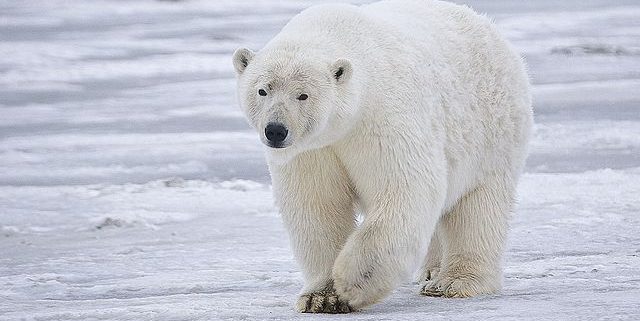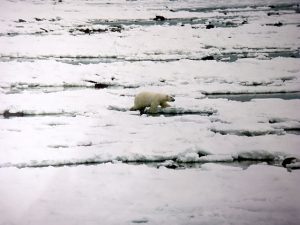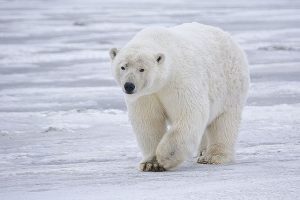Effects of Global Warming on Polar Bears in the Arctic
by Dani Ferraro, RJD intern
Global warming and the loss of Arctic sea ice is affecting populations of polar bears (Ursus maritimus) in Hudson Bay. Localized rises in sea surface temperatures (SST) have lead to mortality events and habitat changes for several marine species (Dulvy et al. 2008). While some species have adaptations that allow them to tolerate warming events, the loss of habitat and consequent die-offs of prey species is devastating. The Hudson Bay Lowlands (HBL), the second largest inland sea in the world and home to polar bears, has warmed approximately three degrees Celsius since the 1990s (Ruhland et al. 2013). With warmer air temperatures and increasingly rising SST comes the loss of winter ice-cover and reduced snow depth. This has directly caused the mortality of polar bear cubs and their prey, the ringed seal (Phoca hispida) and the bearded seal (Erignathus barbatus). As the forage and movement patterns of ringed seals and closely linked with sea ice, loss of this habitat could explain this mortality. The latest population estimates are about 21,500-25,000 individuals throughout the circumpolar Arctic (Luque et al. 2014).
As a k-selected species, polar bears have delayed maturation and high adult survival rates, but smaller litter sizes. Sea ice acts as a polar bear’s hunting grounds, with terrestrial habitats as their maternity and breeding grounds. For female polar bears, impacts beyond loss of habitat exist. With reduced sea ice, females will have a cascading loss of adipose stores, causing lowered reproductive rates. This loss of adipose means that females have less fat to invest in their cubs throughout the winter season and subsequent fasting season. With reducing sea ice thickness, it becomes thinner and more pliable to winds and currents. Polar bears will respond with increased walking or swimming, using higher energy in order to retain their habitat range.
It’s important to acknowledge the differences in sea ice thickness and location. Polar bears prefer the annual sea ice located over the inter-island archipelagos and continental shelf surrounding the polar basis. This sea ice has declined in near shore areas and in amount of multiyear ice. With this decline comes the decrease in preferred habitat locations for polar bears, as well as other pagophilic species throughout the arctic marine ecosystem. Large expanses of open water due to melting sea ice often separates terrestrial maternity dens from residential pack ice. Pregnant females have a tendency to leave their residential areas during ice break-up and remain separated throughout the summer. In order to endure the summer before they can return to sea ice to feed, females need to have built up sufficient fat stores to sustain themselves for at least 8 months. However, considering the preferred location of polar bears: the deep polar basin, where there is a lower seal density, females will find difficulties obtaining sufficient fat stores. Without having accumulated adequate adipose stores, females have fewer nutrients to pass along to nursing cubs. Due to lower energy and fat stores, females are more likely to give birth to single cub litters, often with low survival rates caused by small body mass (Derocher).
With increasing SST and breaking sea ice, polar bears use more energy moving against the direction of ice drift. If ice moves more quickly, more energy is needed to move and hunt accordingly. Once sea ice concentration falls below 50%, polar bears tend to stick to terrestrial environments. Hunting and hauling prey onto land is energetically costly, requiring older polar bears to consume more, leaving fewer scraps for juveniles to scavenge. Combined with lower female productivity, the loss of food for juveniles doesn’t bode well for polar bear populations in the future. The impacts of climate change and global warming are already being seen with increasing sea surface temperature and decreasing sea ice depth. These habitat changes cause a cascading shift down the Arctic ecosystem, from habitat loss to mass mortality and reduced productivity. There will be shifts in survival rates, maturation age, and reproductive rates in populations of polar bears as well as that of its prey, both the bearded seals and ringed seals. With such a limited habitat in the circumpolar Arctic, global warming and climate change have a drastic effect on their populations, environments, and breeding habits.
Derocher, A. (2004). Polar Bears In A Warming Climate. Integrative and Comparative Biology, 163-176.
Dulvy, N.K., Rogers, S.I., Jennings, S., Stelzenmuller, V., Dye, S.R. & Skjoldal, H.R. (2008) Climate change and deepening of the North Sea fish assemblage: a biotic indicator of warming seas. Journal of Applied Ecology, 45, 1029–1039.
Luque, S., Ferguson, S., & Breed, G. (2014). Spatial behaviour of a keystone Arctic marine predator and implications of climate warming in Hudson Bay. Journal of Experimental Marine Biology and Ecology, 504-515.
Ruhland, K., Paterson, A., Keller, W., Michelutti, N., & Smol, J. (2013). Global warming triggers the loss of a key Arctic refugium. Proceedings of the Royal Society B: Biological Sciences, 20131887-20131887.






Leave a Reply
Want to join the discussion?Feel free to contribute!